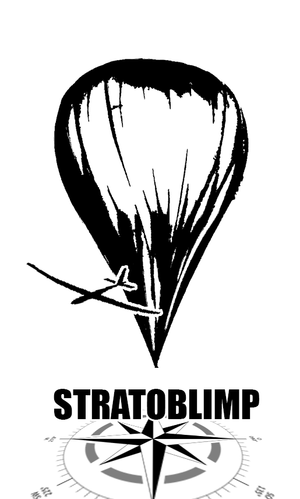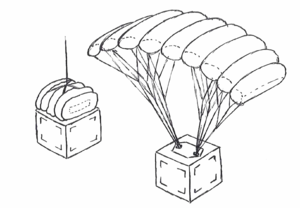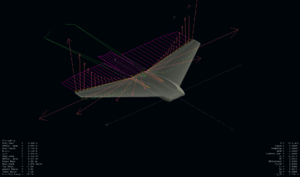Difference between revisions of "TU Delft - StratoBlimp"
| Line 39: | Line 39: | ||
=== Airframe === | === Airframe === | ||
[[File:paraglider. | [[File:paraglider.PNG|thumb|right|Para glider concept]] | ||
The team came to tree different concepts that could fur fill the mission requirements. | The team came to tree different concepts that could fur fill the mission requirements. | ||
The flying wing, a drop shaped glider with a cross tail and a para glider. The para glider was the first concept to be cut due to the difficulty of calculating it's glide properties and the low forward speed it could achieve, making it only suitable to fly in slow wind conditions. | The flying wing, a drop shaped glider with a cross tail and a para glider. The para glider was the first concept to be cut due to the difficulty of calculating it's glide properties and the low forward speed it could achieve, making it only suitable to fly in slow wind conditions. | ||
| Line 45: | Line 45: | ||
The flying wing and drop shaped glider are further analysed in order to be able to choose the best concept. | The flying wing and drop shaped glider are further analysed in order to be able to choose the best concept. | ||
[[File:flyingwingxflr.png|thumb|right|Flying wing analysis in XFLR]] | [[File:flyingwingxflr.png|thumb|right|Flying wing analysis in XFLR]] | ||
=== Stability === | === Stability === | ||
Revision as of 09:32, 3 December 2012
TU Delft - StratoBlimp
On the 12th of November 2012 at the faculty of aerospace engineering of the Delft University of Technology a design synthesises project started called StratoBlimp. Ten students get the task to develop an autonomous UAV that is launched from a balloon in the stratosphere and returns to its launchsite. Ir. B.D.W. Remes of the TU Delft MAV lab, Dr. ir. C.J.M. Verhoeven of the micro electronics department and Ir. S. Engelen of the space systems engineering department are supporting the students on this project.
Objectives
- Launch from a balloon in the stratosphere
- Autonomously return to the launch site
- Use paparazzi for the autopilot system
- Have two-way communication between the ground station and the UAV
- Ability to adapt the landing site in flight
- Try to comply with weather balloon regulations
- Make video of blackness of space
- Have the ability to take a scientific payload
The Team
In alphabetical order, the students working on this project: All are members of the Delft University of Technology faculty of Aerospace Engineering
- S.K. Brunner
- P.J.S. Danneels
- N.G.C. Janssen
- T.P. Langejan
- P.C. Luteijn
- T.L. Mohren
- G. Moors
- P. van Oorschot
- J.A. Siebers
- J.D. Tossyn
Technical Overview
Balloon
Groundstation
UAV
Airframe
The team came to tree different concepts that could fur fill the mission requirements. The flying wing, a drop shaped glider with a cross tail and a para glider. The para glider was the first concept to be cut due to the difficulty of calculating it's glide properties and the low forward speed it could achieve, making it only suitable to fly in slow wind conditions.
The flying wing and drop shaped glider are further analysed in order to be able to choose the best concept.
Stability
Communications
The team is looking into several communication options, the requirement to have two way communication complicates things a lot. To ensure building and operating the system is reachable for everyone the team set the extra requirement of staying outside licensed communication regions. The design must comply with ITU region 1 regulations and laws from The Netherlands and neighbouring countries as this is relevant to this project.
Amateur radio
This falls into the category that needs a license but it is mentioned anyway as it might be a great solution for many similar projects out there. It is being recommended by many developers having experience with high altitude ballooning.
A basic amateur radio license allows for a much greater transmission power in the ISM bands. This enables for a long range uplink in the 70cm band and 2m band.
Using the available amateur radio networks like APRS could make a downlink fairly simple as a ground network already exists.
Direct link unlicensed
Satellite communication
Depending on the mission, satellite communication could be the way to go. It is very reliable but more expensive and you pay per volume so it is not recommended for streaming down data. A good module would be the Iridium 9603. Its mass is about 10 grams [1]. Cost for the module would be around €230 [2] not including antenna. Operation costs for this module are around €10 a month plus €0,05 per 50 bytes transmitted [3]. Messages from the module to the ground could be posted on a web server of your choice using the HTTP POST method. The data could also be send in mail format but this is not practical for this application. Messages to send to the module can be sent to the Iridium gateway.



